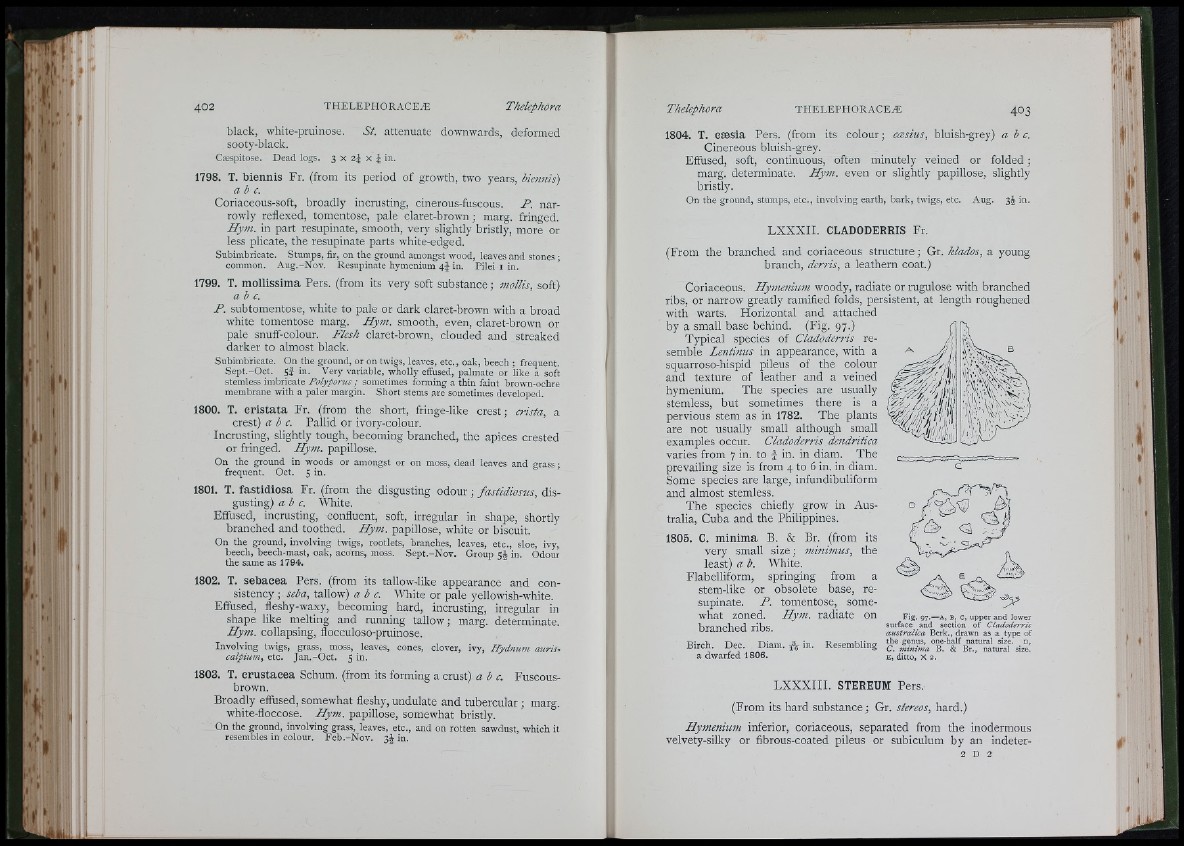
402 THELEPHORACEÆ Thelephora
black, white-pruinose. St. attenuate downwards, deformed
sooty-black.
Cæspitose. Dead logs. 3 x 2® X ® in.
1798. T. biennis Fr. (from its period of growth, two years, biennis)
abc.
Coriaceous-soft, broadly incrusting, cinerous-fuscous. P. narrowly
reflexed, tomentose, pale claret-brown ; marg. fringed.
Hyni. in part resupinate, smooth, very slightly bristly, more or
less plicate, the resupinate parts white-edged.
Subimbricate. Stumps, fir, on the ground amongst wood, leaves and stones •
common. Aug.-Nov. Resupinate hymenium 4® in. Pilei i in. ’
1799. T. mollissima Pers. (from its very soft substance ; mollis, soft)
abc.
P. subtomentose, white to pale or dark claret-brown with a broad
white tomentose marg. Hym. smooth, even, claret-brown or
pale snuff-colour. Flesh claret-brown, clouded and streaked
darker to almost black.
Subimbricate. On the ground, or on twigs, leaves, etc., oak, beech ; frequent.
Sept.-Oct. Sf in. Very variable, wholly effused, palmate or like a soft
stemless imbricate Polyporus ; sometimes forming a thin faint brown-ochre
membrane with a paler margin. Short stems are sometimes developed.
1800. T. eristata Fr. (from the short, fringe-like crest; crista, a
crest) abc. Pallid or ivory-colour.
Incrusting, slightly tough, becoming branched, the apices crested
or fringed. Hym. papillose.
On the ground in woods or amongst or on moss, dead leaves and grass ;
frequent. Oct. 5 in.
1801. T. fastidiosa Fr. (from the disgusting odour ; fastidiosus, disgusting)
abc. White.
Effused, incrusting, confluent, soft, irregular in shape, shortly
branched and toothed. Hym. papillose, white or biscuit.
On the ground, involving twigs, rootlets, branches, leaves, etc., sloe, ivy,
beech, beech-mast, oak, acorns, moss. Sept.-Nov. Group in. Odour
the same as 1794.
1802. T. sebaeea Pers. (from its tallow-like appearance and consistency
; seba, tallow) abc. White or pale yellowish-white.
Effused, fleshy-waxy, becoming hard, incrusting, irregular in
shape like melting and running tallow; marg. determinate.
Hym. collapsing, flocculoso-pruinose.
Involving twigs, grass, moss, leaves, cones, clover, ivy, Hydnum auriscalpium,
etc. Jan.-Oct. 5 in.
1803. T. erustaeea Schum. (from its forming a crust) abc. Fuscousbrown.
Broadly effused, somewhat fleshy, undulate and tubercular ; marg.
white-floccose. Hym. papillose, somewhat bristly.
On the ground, involving grass, leaves, etc., and on rotten sawdust, which it
resembles in colour. Feb.-Nov. 3® in.
Thelephora THELEPHORACEÆ 403
1804. T. esesia Pers. (from its colour; ccesius, bluish-grey) abc .
Cinereous bluish-grey.
Effused, soft, continuous, often minutely veined or folded;
marg. determinate. Hym. even or slightly papillose, slightly
bristly.
On the ground, stumps, etc., involving earth, bark, twigs, etc. Aug. 3® in.
i, ;i , w . i
I
ILXXXII.
CLADODERRIS Fr.
(From the branched and coriaceous structure ; Gr. klados, a young
branch, derris, a leathern coat.)
Coriaceous. Hymenium woody, radiate or rugulose with branched
ribs, or narrow greatly ramified folds, persistent, at length roughened
with warts. Horizontal and attached
by a small base behind. (Fig. 97.)
Typical species of Cladoderris resemble
Lentinus in appearance, with a
squarroso-hispid pileus of the colour
and texture of leather and a veined
hymenium. The species are usually
stemless, but sometimes there is a
pervious stem as in 1782. The plants
are not usually small although small
examples occur. Cladoderris dendritica
varies from 7 in. to f in. in diam. The
prevailing size is from 4 to 6 in. in diam.
Some species are large, infundibuliform
and almost stemless.
The species chiefly grow in Australia,
Cuba and the Philippines.
1805. C. minima B. &
very small size ;
least) a b. White.
Br. (from its
minimus, the
Flabelliform, springing from a
stem-like or obsolete base, resupinate.
P. tomentose, somewhat
zoned. Hym. radiate on Fig. 97.—A, B, c, upper a
branched ribs.
Birch. Dec. Diam. in. Resembling / e !
a dwarfed 1806. e , ditto, x 2.
I*
LXXXIII. STEREUM Pers.
(From its hard substance; Gr. stereos, hard.)
Hymenium inferior, coriaceous, separated from the inodermous
velvety-silky or fibrous-coated pileus or subiculum by an indeter